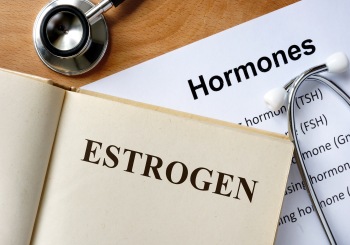One of the main concerns with taking saw palmetto is its potential effect on human hormone levels, particularly estrogen. Estrogen is a hormone that is primarily produced in the ovaries in females and plays a critical role in regulating the menstrual cycle, supporting bone health, and maintaining cardiovascular health. In males, estrogen is produced in smaller quantities and is important for the maintenance of bone density and sexual function. As with any supplement, it is important to talk to your healthcare provider before taking saw palmetto, especially if you have a history of hormone-sensitive conditions such as breast cancer or endometriosis.
How Can Saw Palmetto Affect estrogen levels
The potential impact of saw palmetto on estrogen levels may be due in part to its content of phytoestrogens. Phytoestrogens are plant-based compounds that have a similar structure to human estrogen and can bind to estrogen receptors in the body. Some studies have suggested that phytoestrogens may have a weak estrogenic effect, while others indicate that they may have an anti-estrogenic effect. Obviously, the complete relationship between saw palmetto and estrogen levels is still not fully understood.
In fact, there is conflicting evidence regarding the effects of saw palmetto on estrogen levels. Some studies suggest that saw palmetto may reduce estrogen levels in the body, while others indicate that it has no effect on estrogen levels or may even increase them.
No Affect on Estrogen
A study published in the Journal of the American Medical Association found that saw palmetto had no effect on levels of estradiol, a type of estrogen, in men with BPH. It was a randomized, double-blind, placebo-controlled study published in 2011. It involved 369 men who were randomly assigned to receive either a saw palmetto supplement or a placebo for 72 weeks. The researchers found that there was no significant difference in estradiol levels between the two groups at any time during the study, indicating that saw palmetto did not increase estrogen levels in these men.
Similarly, a study published in the Journal of Alternative and Complementary Medicine in 2002 found that saw palmetto had no effect on estrogen levels in postmenopausal women with hair loss. The study involved 10 women who received a saw palmetto supplement for three months. The researchers found that there was no significant change in levels of the estrogen hormones estrone or estradiol during the study, indicating that saw palmetto did not increase estrogen levels in these women.
Another study published in the Journal of Herbal Pharmacotherapy in 2005 evaluated the effect of saw palmetto supplementation on hormone levels in healthy men. The study involved 10 men who received a saw palmetto supplement for two weeks. The researchers found that there was no significant change in levels of the estrogen hormones estradiol or estrone during the study, indicating that saw palmetto did not increase estrogen levels in these men.
While these studies suggest that saw palmetto does not increase estrogen levels in men or women, it is important to note that other studies have produced conflicting results.
Reduction in Estrogen Levels
However, other studies suggest that saw palmetto may reduce estrogen levels.
For instance, a study published in the Journal of Medicinal Food in 2012 found that saw palmetto extract decreased estrogen levels in rats with induced BPH. The study involved 60 rats, which were divided into six groups and received either saw palmetto extract, finasteride (a medication commonly used to treat BPH), or a placebo for six weeks. The researchers found that the rats who received saw palmetto extract had significantly lower levels of estrogen in their serum and prostate tissues compared to the rats in the placebo group. The study suggests that saw palmetto extract may have an anti-estrogenic effect in rats with induced BPH.
A study published in the Journal of Clinical Psychopharmacology in 2009 investigated the effect of saw palmetto extract on hormone levels in men with major depressive disorder. The study involved 40 men, who were randomized to receive either saw palmetto extract or a placebo for 12 weeks. The researchers found that the men who received saw palmetto extract had significantly lower levels of estradiol (a type of estrogen) in their serum compared to the men in the placebo group. The study suggests that saw palmetto extract may have an anti-estrogenic effect in men with major depressive disorder.
Another study published in the Journal of Clinical Psychopharmacology found that saw palmetto extract reduced estrogen levels in men with major depressive disorder (MDD). The study involved 40 men with MDD who were randomly assigned to receive either saw palmetto extract or placebo for 12 weeks. Blood samples were collected from the participants at the beginning of the study and at the end of the 12-week treatment period to measure hormone levels.
The results of the study showed that men who received saw palmetto extract had significantly lower levels of estradiol, a type of estrogen, compared to men who received placebo. The saw palmetto extract did not significantly affect levels of testosterone or other hormones.
The researchers suggest that the reduction in estradiol levels observed in the saw palmetto group may be related to the antidepressant effects of the extract. The study authors proposed that elevated estradiol levels may contribute to depression symptoms in some men, and that reducing estradiol levels with saw palmetto extract may help to alleviate depression symptoms.
However, it is important to note that this study involved a relatively small number of participants and was conducted in men with major depressive disorder, so it is unclear whether the findings are generalizable to other populations. Additionally, the study did not investigate the long-term effects of saw palmetto extract on hormone levels or depression symptoms.
So, overall the evidence of saw palmetto’s affect on estrogen levels appears inconclusive. Of course, it is important to note that these studies were conducted in rats and humans with specific health conditions, and the findings may not be generalizable to healthy individuals.
How Can Saw Palmetto Reduce Estrogen
Saw palmetto contains several compounds that are classified as phytoestrogens, which are plant-derived compounds that can interact with estrogen receptors in the body. Phytoestrogens can have both estrogenic and antiestrogenic effects, depending on the type of phytoestrogen and the tissue it is acting on. This can make the effects of phytoestrogens on estrogen levels complex and difficult to predict.
Some of the phytoestrogens found in saw palmetto include beta-sitosterol, stigmasterol, and campesterol. These compounds are structurally similar to estrogen and can bind to estrogen receptors in the body, but they do not have the same potency as endogenous estrogen. Some studies suggest that the phytoestrogens in saw palmetto may have an anti-estrogenic effect, meaning they can block the effects of estrogen in certain tissues. For example, a study published in the Journal of Steroid Biochemistry and Molecular Biology in 2004 found that beta-sitosterol, one of the phytoestrogens found in saw palmetto, could inhibit the growth of human breast cancer cells by blocking estrogen receptors.
However, the effects of phytoestrogens on estrogen levels can be influenced by many factors, including dosage, timing, and individual differences in metabolism. Some studies suggest that high doses of phytoestrogens may actually increase estrogen levels in some tissues, while low doses may have an anti-estrogenic effect. Therefore, it is difficult to predict the overall impact of the phytoestrogens in saw palmetto on estrogen levels in the body.
Dosage and Frequency of Saw Palmetto on Estrogen
The effect of saw palmetto on hormone levels, including estrogen, may be influenced by several factors, including the dosage and frequency of consumption.
Dosage:
The optimal dosage of saw palmetto for hormone regulation is still unclear, as different studies have used different doses of saw palmetto extract. In general, the recommended dosage of saw palmetto extract ranges from 160-320 mg per day. However, some studies have used higher doses (up to 960 mg per day) without observing any adverse effects. It is important to note that taking too much saw palmetto extract can lead to side effects such as gastrointestinal upset and headaches.
Frequency:
The frequency of consumption may also impact the duration of saw palmetto’s effect on hormone levels, as regular consumption may lead to a sustained effect on hormone regulation.
It is also worth noting that the individual differences in metabolism and hormone levels may influence the effects of saw palmetto on estrogen levels. Therefore, the impact of saw palmetto on hormone levels may vary among individuals.
Individual differences in hormone levels may influence the response to saw palmetto consumption. Hormone levels vary among individuals due to genetics, age, sex, lifestyle, and other factors. As saw palmetto is believed to interact with hormone receptors in the body, these individual differences may impact the effects of saw palmetto on hormone levels, including estrogen.
For example, individuals with high estrogen levels may respond differently to saw palmetto consumption compared to those with low estrogen levels. In individuals with high estrogen levels, saw palmetto may have a weaker estrogenic effect, while in individuals with low estrogen levels, it may have a stronger effect. Additionally, the duration of exposure to saw palmetto may also influence the response, as individuals with longer exposure to saw palmetto may have a greater effect on their hormone levels compared to those with shorter exposure.
Certain genetic variations may also impact the response to saw palmetto consumption. For instance, genetic variations in estrogen receptors may influence how an individual responds to the estrogenic and antiestrogenic effects of saw palmetto. Similarly, variations in genes involved in the metabolism and elimination of saw palmetto compounds may also influence the response to saw palmetto consumption.
Older individuals may have a different response to saw palmetto compared to younger individuals due to changes in hormone levels with age. Additionally, sex differences in hormone levels may also impact the response to saw palmetto consumption, as men and women have different levels of estrogen and other hormones.
Saw Palmetto and Estrogen Levels in Men
The evidence regarding the effect of saw palmetto on estrogen levels in men is mixed, and it is not entirely clear whether saw palmetto consumption can increase relative estrogen levels in men.
Some studies have suggested that saw palmetto may have an antiestrogenic effect in men by inhibiting the conversion of testosterone to estrogen, while others have suggested that it may have a weak estrogenic effect by increasing levels of estrogen in the body.
In a randomized, double-blind, placebo-controlled trial, 40 men with BPH were treated with saw palmetto extract for six months. The study found that saw palmetto extract did not increase estrogen levels in the participants. In another study, a small number of men with low testosterone levels and symptoms of androgen deficiency were given saw palmetto extract for six months. The study found that saw palmetto extract did not increase estrogen levels in the participants.
However, a few case reports have suggested that saw palmetto consumption may be associated with gynecomastia, which is the development of breast tissue in men. Gynecomastia is often caused by a relative excess of estrogen in the body. However, these cases are relatively rare, and more research is needed to understand the potential link between saw palmetto consumption and gynecomastia.
Estrogen – Testosterone Balance in Men
The evidence regarding the effect of saw palmetto on the estrogen-testosterone balance in men is mixed, and it is not entirely clear whether saw palmetto consumption affects this balance.
Some studies suggest that saw palmetto may have an antiestrogenic effect in men by inhibiting the conversion of testosterone to estrogen. In theory, this may help to maintain a healthy estrogen-testosterone balance in men. However, other studies have suggested that saw palmetto may have a weak estrogenic effect by increasing levels of estrogen in the body, which could potentially disrupt the estrogen-testosterone balance.
There is also some evidence to suggest that saw palmetto may have a direct effect on testosterone levels in men. For example, a small study published in the Journal of Urology found that saw palmetto supplementation for six months resulted in a slight reduction in serum testosterone levels in men with benign prostatic hyperplasia (BPH). However, other studies have not observed a significant effect of saw palmetto on testosterone levels in men.
Again, the evidence regarding the effect of saw palmetto on the estrogen-testosterone balance in men is mixed, and more research is needed.


